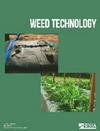Spray Interval, Application Order, and Plant Height Influences Control of Dicamba-Resistant Palmer amaranth
IF 1.7
3区 农林科学
Q3 AGRONOMY
引用次数: 0
Abstract
Palmer amaranth, which is resistant to glyphosate and protoporphyrinogen oxidase inhibitors, remains a threat to cotton and soybean production in Tennessee. This is partly due to the recent evolution of dicamba-resistant Palmer amaranth in West Tennessee, which further complicates weed management. Experiments were conducted in 2021 and 2022 to determine the best timing between sequential applications and in what order 2,4-D or dicamba should be used with glufosinate to control resistant Palmer amaranth. Palmer amaranth control increased when the interval between postemergence herbicide applications decreased from 21 to 7 days. At the 7-day interval in a dicamba-based system, the order of herbicides did not affect Palmer amaranth control. However, in a 2,4-D-based system, the greatest control was achieved when 2,4-D was applied first, followed by either 2,4-D or glufosinate. While weed height at the time of application had a significant effect on Palmer amaranth control with auxin herbicides, control was still unacceptable in the field at the labeled rates of dicamba or 2,4-D when applied to <10 cm tall weeds (48% and 53%, respectively). Neither dicamba nor 2,4-D provided acceptable control of the Palmer amaranth populations evaluated. Sequential applications separated by 7 days provided better weed control than those separated by 21 days. Given that the better 7-day sequential treatments provided less than 90% control and resulted in more than 64,000 surviving Palmer amaranth ha喷洒间隔、施药顺序和植株高度对抗性麦草畏的帕尔默苋防治效果的影响
对草甘膦和原卟啉原氧化酶抑制剂具有抗性的帕尔默苋仍然威胁着田纳西州的棉花和大豆生产。部分原因是田纳西州西部最近出现了抗麦草畏的帕尔默苋,这使得杂草管理更加复杂。2021 年和 2022 年进行了实验,以确定连续施药的最佳时机,以及 2,4-D 或麦草畏与草铵膦的使用顺序,从而控制抗性帕尔默苋。当芽后除草剂施用间隔期从 21 天缩短到 7 天时,对帕尔默苋的控制能力会增强。在以麦草畏为基础的系统中,间隔期为 7 天时,除草剂的使用顺序不会影响对帕尔默苋的控制。然而,在以 2,4-D 为基础的系统中,先施用 2,4-D 后施用 2,4-D 或草铵膦的控制效果最好。虽然施药时的杂草高度对使用辅助除草剂控制帕尔默苋的效果有显著影响,但在田间,当对<10厘米高的杂草施用麦草畏或2,4-D(分别为48%和53%)时,其标注剂量的控制效果仍然不可接受。麦草畏和 2,4-D 都不能对所评估的帕尔默苋种群提供可接受的控制效果。相隔 7 天连续施药比相隔 21 天连续施药的除草效果更好。鉴于较好的 7 天连续施用除草剂的除草效果不到 90%,而存活的帕尔默苋的株数却超过了每公顷 64,000 株,这表明仅仅依靠这些除草剂来控制帕尔默苋并不是一种可持续的杂草管理策略。
本文章由计算机程序翻译,如有差异,请以英文原文为准。
求助全文
约1分钟内获得全文
求助全文
来源期刊

Weed Technology
农林科学-农艺学
CiteScore
2.90
自引率
21.40%
发文量
89
审稿时长
12-24 weeks
期刊介绍:
Weed Technology publishes original research and scholarship in the form of peer-reviewed articles focused on understanding how weeds are managed.
The journal focuses on:
- Applied aspects concerning the management of weeds in agricultural systems
- Herbicides used to manage undesired vegetation, weed biology and control
- Weed/crop management systems
- Reports of new weed problems
-New technologies for weed management and special articles emphasizing technology transfer to improve weed control
-Articles dealing with plant growth regulators and management of undesired plant growth may also be accepted, provided there is clear relevance to weed science technology, e.g., turfgrass or woody plant management along rights-of-way, vegetation management in forest, aquatic, or other non-crop situations.
-Surveys, education, and extension topics related to weeds will also be considered
 求助内容:
求助内容: 应助结果提醒方式:
应助结果提醒方式:


